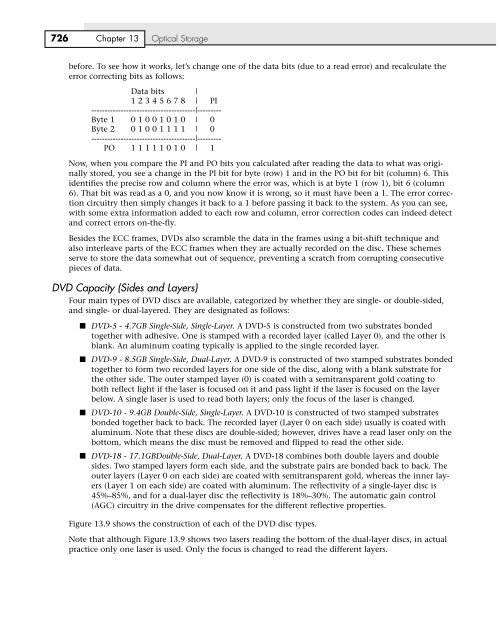Create successful ePaper yourself
Turn your PDF publications into a flip-book with our unique Google optimized e-Paper software.
726 Chapter <strong>13</strong> Optical Storage<br />
before. To see how it works, let’s change one of the data bits (due to a read error) and recalculate the<br />
error correcting bits as follows:<br />
Data bits |<br />
1 2 3 4 5 6 7 8 | PI<br />
---------------------------------------|---------<br />
Byte 1 0 1 0 0 1 0 1 0 | 0<br />
Byte 2 0 1 0 0 1 1 1 1 | 0<br />
---------------------------------------|---------<br />
PO 1 1 1 1 1 0 1 0 | 1<br />
Now, when you compare the PI and PO bits you calculated after reading the data to what was originally<br />
stored, you see a change in the PI bit for byte (row) 1 and in the PO bit for bit (column) 6. This<br />
identifies the precise row and column where the error was, which is at byte 1 (row 1), bit 6 (column<br />
6). That bit was read as a 0, and you now know it is wrong, so it must have been a 1. The error correction<br />
circuitry then simply changes it back to a 1 before passing it back to the system. As you can see,<br />
with some extra information added to each row and column, error correction codes can indeed detect<br />
and correct errors on-the-fly.<br />
Besides the ECC frames, DVDs also scramble the data in the frames using a bit-shift technique and<br />
also interleave parts of the ECC frames when they are actually recorded on the disc. These schemes<br />
serve to store the data somewhat out of sequence, preventing a scratch from corrupting consecutive<br />
pieces of data.<br />
DVD Capacity (Sides and Layers)<br />
Four main types of DVD discs are available, categorized by whether they are single- or double-sided,<br />
and single- or dual-layered. They are designated as follows:<br />
■ DVD-5 - 4.7GB Single-Side, Single-Layer. A DVD-5 is constructed from two substrates bonded<br />
together with adhesive. One is stamped with a recorded layer (called Layer 0), and the other is<br />
blank. An aluminum coating typically is applied to the single recorded layer.<br />
■ DVD-9 - 8.5GB Single-Side, Dual-Layer. A DVD-9 is constructed of two stamped substrates bonded<br />
together to form two recorded layers for one side of the disc, along with a blank substrate for<br />
the other side. The outer stamped layer (0) is coated with a semitransparent gold coating to<br />
both reflect light if the laser is focused on it and pass light if the laser is focused on the layer<br />
below. A single laser is used to read both layers; only the focus of the laser is changed.<br />
■ DVD-10 - 9.4GB Double-Side, Single-Layer. A DVD-10 is constructed of two stamped substrates<br />
bonded together back to back. The recorded layer (Layer 0 on each side) usually is coated with<br />
aluminum. Note that these discs are double-sided; however, drives have a read laser only on the<br />
bottom, which means the disc must be removed and flipped to read the other side.<br />
■ DVD-18 - 17.1GBDouble-Side, Dual-Layer. A DVD-18 combines both double layers and double<br />
sides. Two stamped layers form each side, and the substrate pairs are bonded back to back. The<br />
outer layers (Layer 0 on each side) are coated with semitransparent gold, whereas the inner layers<br />
(Layer 1 on each side) are coated with aluminum. The reflectivity of a single-layer disc is<br />
45%–85%, and for a dual-layer disc the reflectivity is 18%–30%. The automatic gain control<br />
(AGC) circuitry in the drive compensates for the different reflective properties.<br />
Figure <strong>13</strong>.9 shows the construction of each of the DVD disc types.<br />
Note that although Figure <strong>13</strong>.9 shows two lasers reading the bottom of the dual-layer discs, in actual<br />
practice only one laser is used. Only the focus is changed to read the different layers.
















